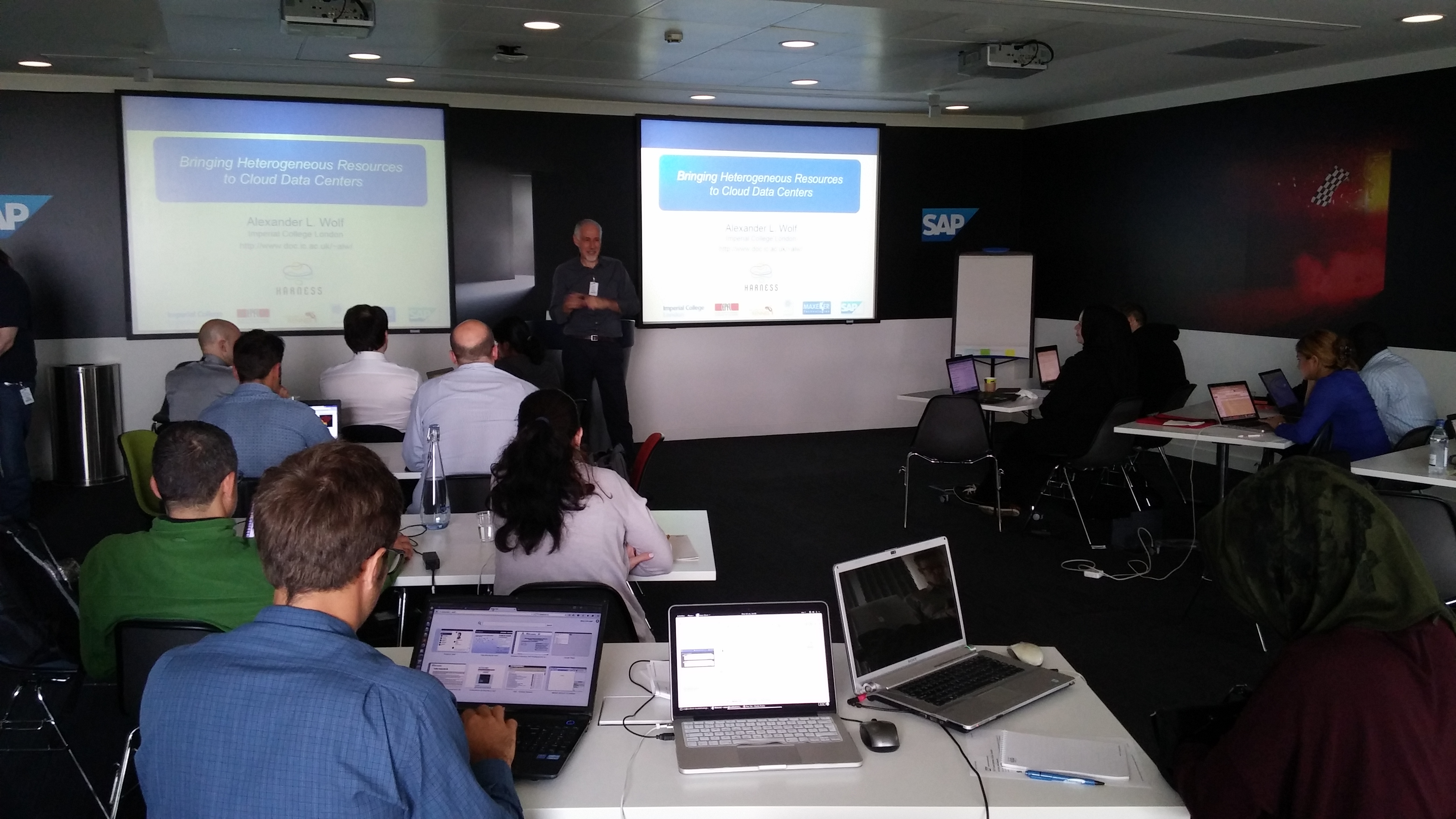
In July 2015, the HARNESS project hosted a Software Carpentry bootcamp/workshop
at the SAP headquarters in Feltham, near London Heathrow. This was an outreach
activity with three distinct, but related, objectives: 1) to disseminate
HARNESS project outcomes to the research community, 2) to bring together
researchers interested in topics relevant to HARNESS, and 3) provide skills and
knowledge training as a public service to contribute toward the improvement
computational science practice within the European Union. This activity was
particularly targeted at the HPC'',cloud research”, and ``heterogeneous
compute research” communities discussed in the HARNESS deliverable
documentation. In addition to the standard topics on task automation, version
control, and programming in python, there were additional modules on cloud
computing, FPGA data-flow engines, and distributed file systems.
Representatives from both the Software Sustainability Institute and the
European Grid Infrastructure attended to provide additional teaching support.
The full list of topics covered was as follows:
- Automating Tasks with the Unix Shell (Alistair Grant, SSI)
- Version Control with Git (Alistair Grant, SSI)
- Building Programs with Python (Mark Stillwell, HARNESS, ICL)
- Managing Cloud Services with ConPaaS (Guillaume Pierre, HARNESS, UR1)
- Dataflow Programming with Maxeler (Peter Sanders, HARNESS, Maxeler)
- EGI Federated Cloud for Open Science (Diego Scardaci and Gergely Sipos, EGI)
- Distributed Filesystems with XtreemFS (Christoph Kleinweber, HARNESS, ZIB)
The first three modules; Automating Tasks with the Unix Shell, Version Control with Git, and Building Programs with Python; were drawn from the standard Software Carpentry curriculum. These modules cover essential core skills for computational science and so contributed directy to the third objective of providing skills and knowledge training as described above, and the inclusion of these modules is required for a workshop to be branded as a Software Carpentry bootcamp. The Software Carpentry organization publishes lessons and guidance on workshop hosting, and has an established reputation for quality, and so we believe that the inclusion of these materials was strategic for driving outside interest in this activity. As an additional consideration, covering these materials made it possible to target a wider pool of users than would have been possible otherwise, and to ensure that they would possess the essential skills to follow the more advanced HARNESS-specific lessons.
Three of the remaining four modules were developed specially for this course to showcase HARNESS-related technologies. In Managing Cloud Services with ConPaaS, Guillaume Pierre from UR1 lead the attendees through using the ConPaaS web service interface to deploy a WordPress blog. In Dataflow Programming with Maxeler, Peter Sanders from Maxeler discussed how FPGA data flow engines achieve computational speedup over conventional CPUs despite their lower Mhz ratings by allowing users to create deep processing pipelines, and showed attendees how to develop custom FPGA configurations using the Maxeler IDE. Attendees were even given access to a virtual machine running a DFE similar so they could follow along with the programming exercises on their own laptops. In Distributed Filesystems with XtreemFS, Christoph Kleinweber from ZIB explained the differences between networked and distributed filesystems and showed attendees how to build a storage solution using XtreemFS.
Finally, in EGI Federated Cloud for Open Science Diego Scardaci and Gergely Sipos from EGI, a separate project with collaborative ties to HARNESS, demonstrated how attendees could access the EGI federated cloud, a multi-site research oriented and publicly funded cloud targeted at computational researchers in the European Union.
There was also a keynote on the topic of Heterogeneous Accelerators in the Cloud given by Professor Alexander Wolf (HARNESS, ICL), and a demonstration of the HARNESS cloud platform given by Gabriel Coutinho (HARNESS, ICL).
Response
This was a popular and well attended event. It was advertised primarily through the web and social media, including facebook, twitter, LinkedIn, and various targeted email lists. By the start of the event, 42 people had signed up and there was growing waiting list. Of these, 25 attended, which was a slightly higher drop-off than expected, possibly due to difficulties in reaching the location via public transport.
The informal feedback offered during the workshop was almost uniformly positive. Overall, the learners seemed happy with the content and breadth of topics covered. A number of attendees expressed that they were very happy to have the opportunity to take a higher-level survey of recent developments and cutting-edge technologies, even when there might not be immediate applications for their particular research area. The attendees were particularly enthusiastic about the keynote, and even though teaching ran late on the last day, a solid majority remained to watch the demonstration of the HARNESS technology preview.
Survey Results
Those who signed up for the event were asked to complete pre-event surveys, while those who actually attended were asked to complete post-event surveys as well. The purpose of the pre-event surveys was to assess information about the background and relative level of knowledge of those who would be attending in order to properly target the lessons. The purpose of the post-event surveys was to determine level of satisfaction and take on feedback that to improve the lessons and future events.
Of the 42 people who signed up, 25 submitted responses to the pre-event survey, which was a higher response rate than expected. Interestingly, 4 people who attended the event did not respond to the survey, and similarly, 4 people who responded to the survey did not attend the event. Most of the survey respondents were researchers associated with universities in England, though one was from Belfast and another from Italy, and three others remain of indeterminate origin. There were 8 responses from females and 17 from males, and, with only a few exceptions, those who responded appeared to be at a relatively early career stage. For more details about the career stage and background of the respondents, please refer to the following figures:
Of the 25 people who attended the workshop, 10 responded to the post-event survey, and all of these had previously responded to the pre-event survey. There was some variation in the satisfaction with individual lessons, but none stood out as being particularly unsatisfying to the attendees. The overall level of reported satisfaction was good, with 7 out of 10 responses indicating that the attendee was “satisfied” or “very satisfied” with the event, and only one person reporting that they were “unsatisfied”. Similarly, 8 out of 10 attendees reported that they were “likely” or “very likely” to recommend similar events to colleagues in the future, while only one person reported that they were “unlikely” to recommend this or similar events.
Conclusions
Overall, we were happy with the number of attendees and we believe that the interest and level of engagement displayed were much higher than if we had simply presented HARNESS in a more typical venue, such as a workshop or trade show. The drop-off from 42 (our maximum capacity) signed up, to 25 attending was disappointing, and likely had to do with difficulty in reaching the location, so we will take this problem into account when planning similar events in the future. There were no major technical glitches that ruined an entire lesson, but there were some delays caused by improperly configured software, and one of the cloud services did not respond well to the load it was given, thus demonstrating the need to allocate sufficient time for debugging and thoroughly test everything in advance.


